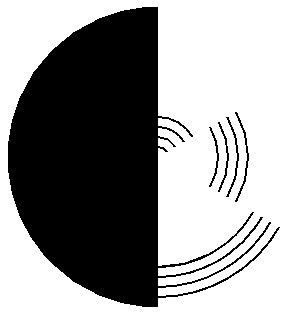
Benham's Top and Subjective Colors
Background:
In 1894 Charles Benham designed an "Artifical Spectrum Top" which is now known as Benham's top. The top is printed using only black and white ink, yet when it is spun at an appropriate speed, colors seem to appear. These colors are called subjective colors (or if you are a fan of Gustav like me, you can call them Fechner colors). While all colors are subjective (remember that color is a psychological phenomenon), the term "subjective colors" is used to refer to the perception of color when the wavelengths of light reaching the eye do not correspond to the percept of the color.

Why subjective colors appear is not well understood. Part of the effect probably arises in the retina. In particular it seems that the response of the retinal ganglion cells occurs more quickly for some colors than for others. Part of the effect probably occurs cortically as well. In particular, the feedback (top-down) from V4 to V2 and from V2 to V1 is different for subjective colors and perceptually matched physical colors.
A Warning:
Some people are sensitive to flickering lights. In extreme cases, the right rate of flickering can induce a seizure. If you are sensitive to flickering lights or are prone to seizures, you should not start the top spinning.
The Activity:
You can create a simulation of Benham's top by typing a pattern for the top and then clicking on the "Make Top" button. The pattern consists of a combination of three letters: B -- color a sector of the top black, W -- color a sector of the top white, and L -- draw arcs in a sector. The size of the sector depends on how many letters are in the pattern -- more letters equal smaller sectors.
For example, the default pattern is BBBAWW. Because there are six letters in the pattern, each sector will occupy one sixth of the circle. The first three sectors (collectly one half of the circle) will be black (BBB). Next will come one sector (one sixth of the circle) with a pattern of arcs (A). Finally, the last two sectors (one third of the circle) will be white (WW).
Once you have typed a pattern for the top, click on the Make Top button. Start the top spinning by clicking on the Start button. A subjective color should appear.
Top Pattern: (B=black sector, A=arcs sector, W=white sector)
Rotation Rate:
1 rotation per second
2 rotations per second
3 rotations per second
4 rotations per second
5 rotations per second
6 rotations per second
7 rotations per second
8 rotations per second
See the warning above before clicking on the Start button.
The classic patterns to try are BBBAWW, BBBWAW and BBBWWA. Each should produce a different subjective color. You should try some patterns of your own too. According to the literature, subjective colors are most likely to appear if the rate of rotation is between 3 and 5 rotations per second. Personally, a slightly faster rotation rate works best for me.
Don't Believe Me?
If you think that I changed the colors of the arcs once the top is spinning, you are wrong. The simplest way of proving to yourself that the top is really black and white (shades of gray will also appear because of the way your computer draws and re-draws the top as it spins) is to take a picture of the rotating top with your phone. The picture of the top will be black and white (and gray), thus proving that I'm not playing games. The subjective colors really are in your visual system and not in the top per se.
Are you really paranoid and think that I can somehow mess with your phone too? Stop the top from spinning and print it in black and white. Cut it out and make a top out of it. Spin your black and white top -- try to get three to five rotations per second -- and look for the subjective colors.